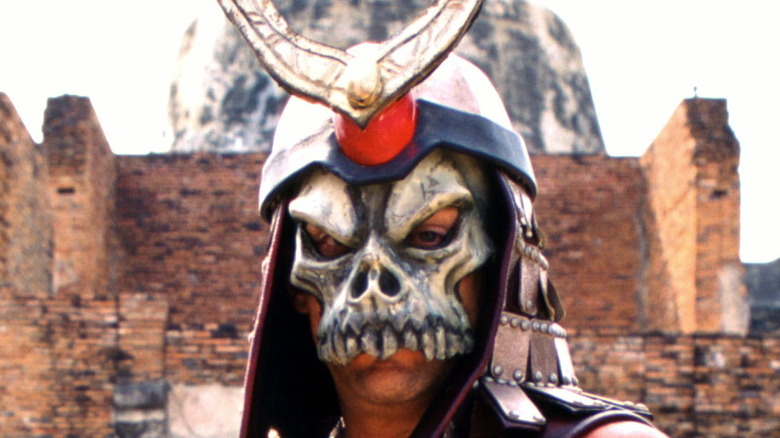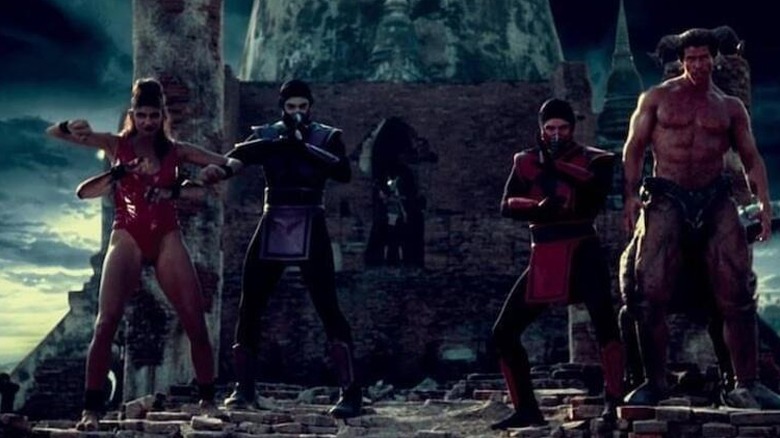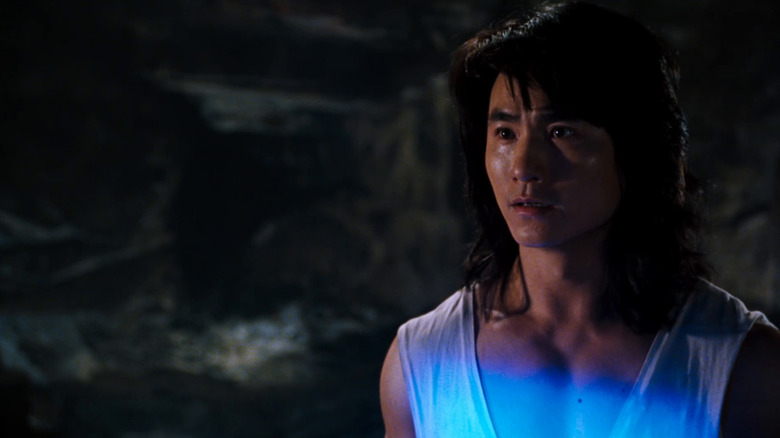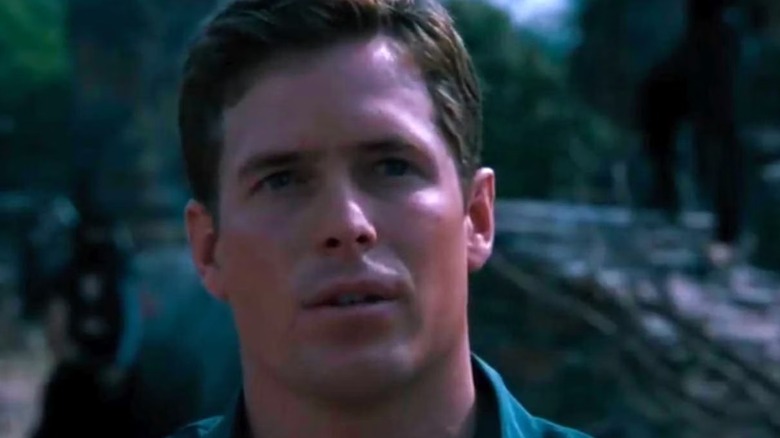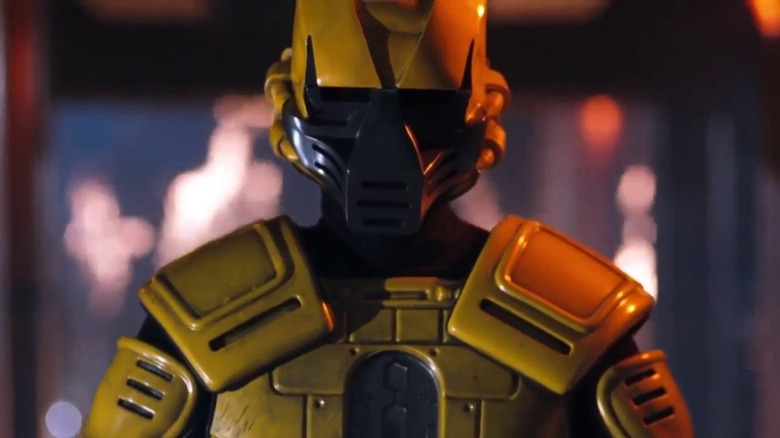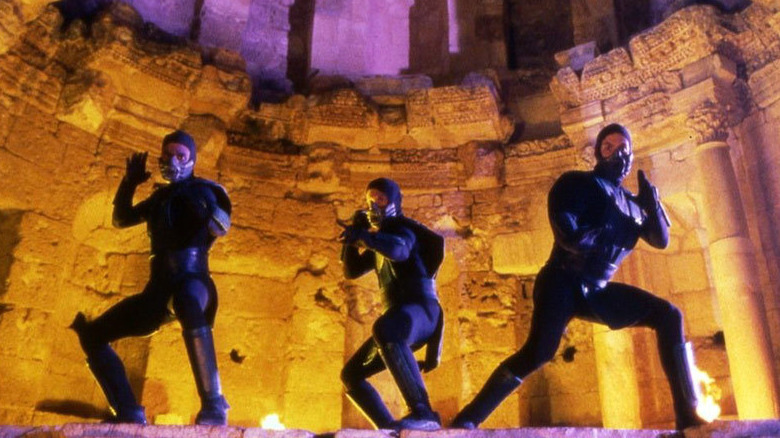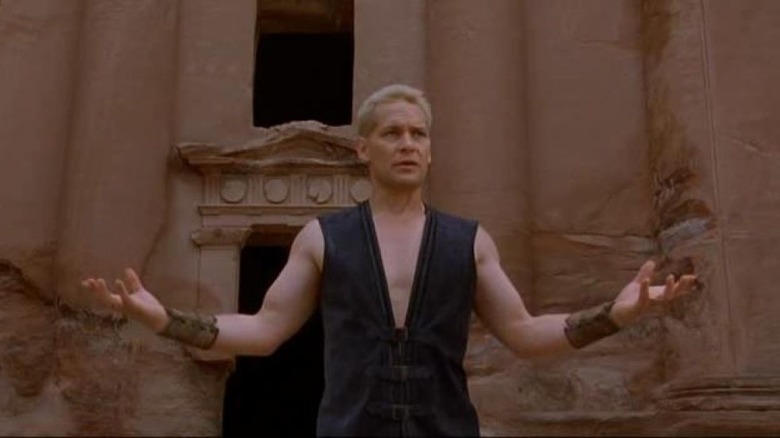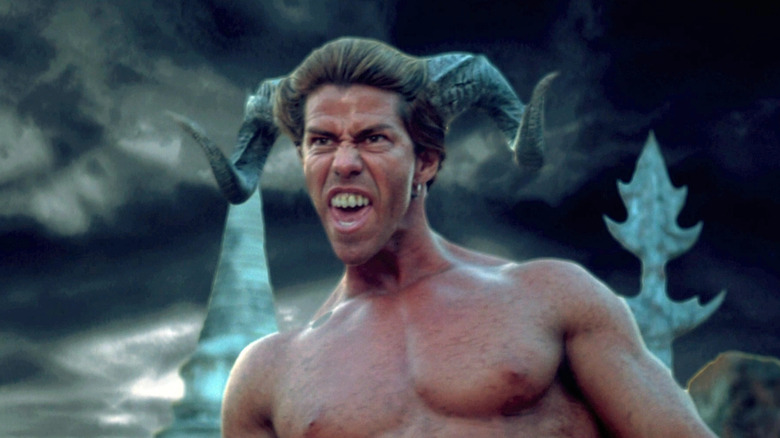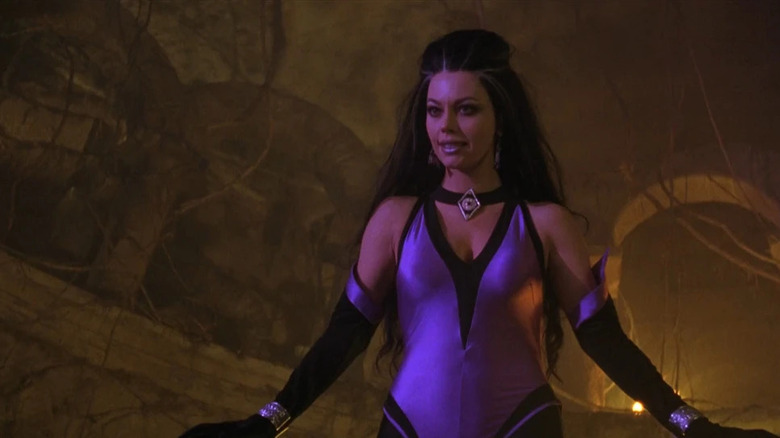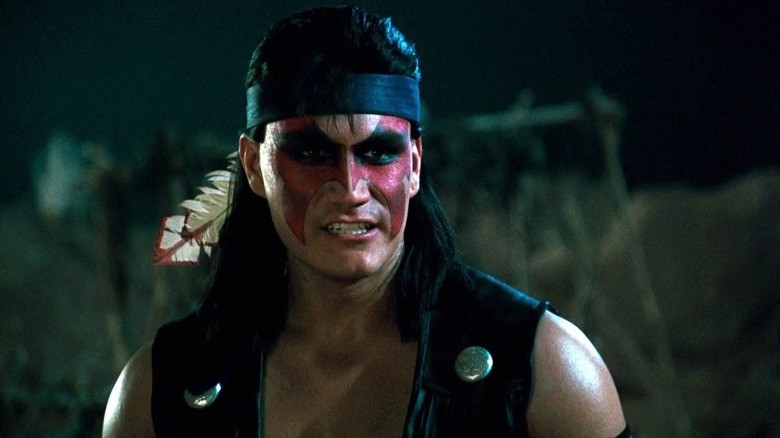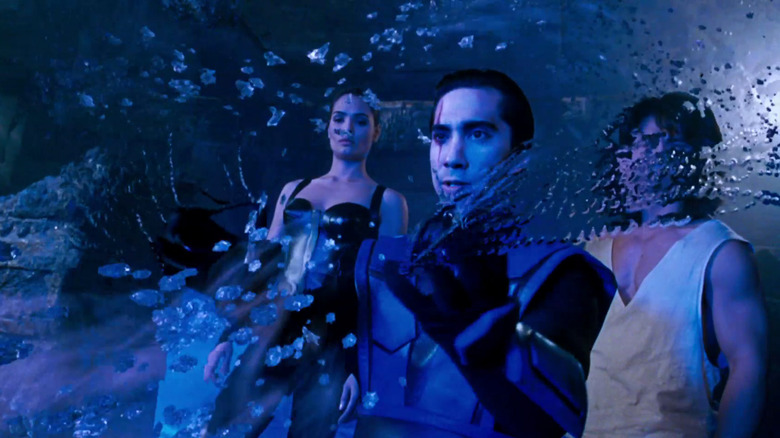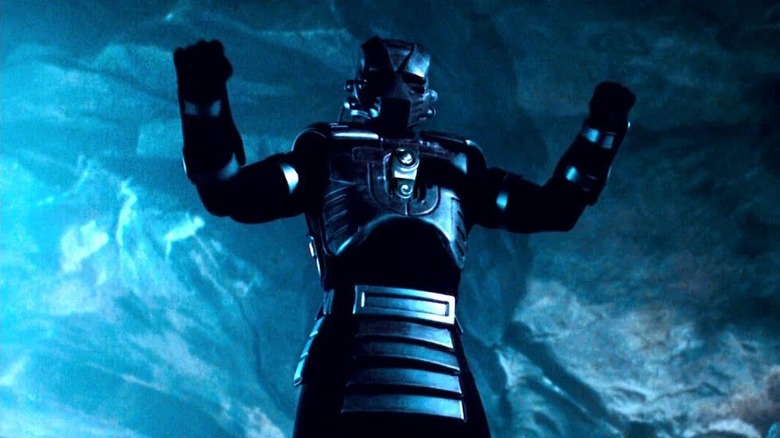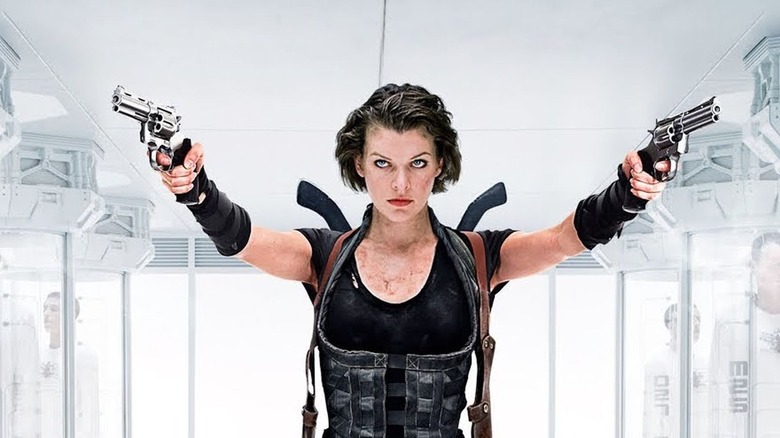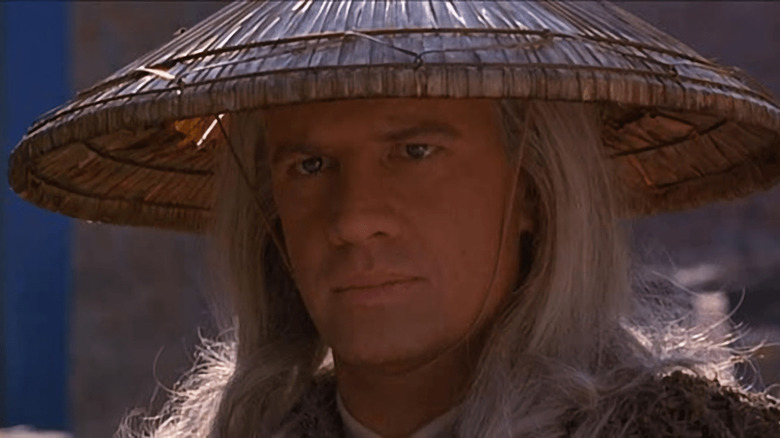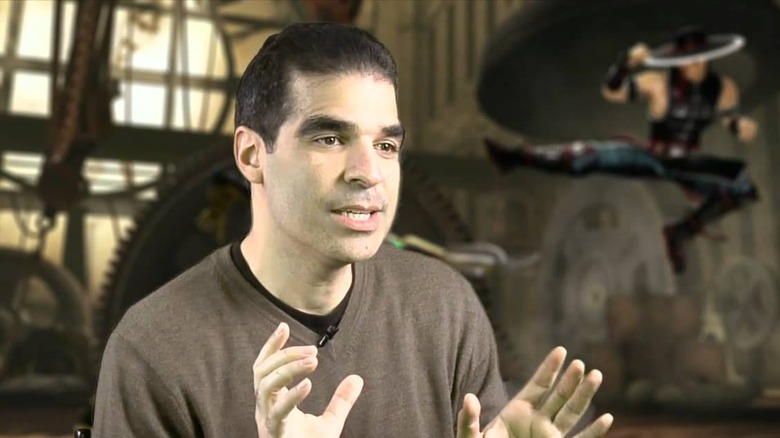The Untold Truth Of Mortal Kombat: Annihilation
There's little doubt that one of the most popular fighting games in history is "Mortal Kombat," first launched in 1991 and almost immediately known for shocking audiences with its gratuitous violence. Depicting the champions of Earthrealm and Outworld entered into a lethal martial arts tournament, the world had never seen anything like it.
Following the success of those video games, "Mortal Kombat" spawned a line of sequels and merchandising, and the game's narrative was adapted into both live-action and animated film and television. 1995 brought the first live-action film, followed shortly thereafter by the 1997 direct sequel "Mortal Kombat: Annihilation," which picked up from the previous film's cliffhanger ending involving the villainous Shao Khan (Brian Thompson), targeting Earth's greatest heroes.
In contrast to the 1995 "Kombat," "Annihilation" was almost universally reviled; it earned $51 million at the worldwide box office, and today resides at a paltry 4% on Rotten Tomatoes. That Sub-Zero-like icy reception killed any hopes for an immediate follow-up, and it would take 24 years before "Mortal Kombat" would once again get a film.
Below is the story behind the troubled production of "Annihilation," from its rushed production schedule to numerous high-profile departures from its principal cast and crew.
Annihilation increased the number of overseas shooting locations
Whereas the 1995 "Kombat" was filmed in California and Thailand, "Annihilation" was more ambitious, traveling to a higher number of countries for filming locations during principal photography. In a 1997 interview with GamePro, producer Lawrence Kasanoff touted such ambitions, promising the film would be bigger in scope and action than its more modest predecessor. This meant more scenes set within the parallel universe of Outworld — and more exotic locations lending an otherworldly aesthetic to the proceedings.
While retaining its predecessor's filming location of Thailand, "Annihilation" also shot scenes on location in Israel, Jordan, and the United Kingdom, with the latter location shoot including the abandoned copper mine Parys Mountain. In a 1997 interview timed to coincide with the film's release, Kasanoff explained that wet, windy weather conditions at a Welsh copper mine had hampered filming. The winds picked up so dramatically, in fact, that the production's base camp was blown away.
Liu Kang's stunt double had a celebrated movie star career
One of the few actors from the 1995 "Mortal Kombat" film to return for "Annihilation" was Robin Shou, reprising his fan-favorite role as master martial artist Liu Kang. While Shou performed many of his own fight scenes, he did have a stunt performer double for certain aspects of his performance. Doubling for Shou in "Annihilation" was Thai actor and stunt choreographer Tony Jaa, who would go on to have his own celebrated career as a martial arts movie star.
Jaa became known to international audiences after starring in the 2003 martial arts film "Ong-Bak: The Thai Warrior," showcasing Thailand's muay thai martial arts style. Jaa has since gone on to appear in "Furious 7" and "Monster Hunter," continuing to display his impressive skills on-screen. Though Jaa had done stunt work in local Thai films, "Annihilation" provided him a major stepping stone, with Jaa recalling years later his good fortune in fitting Shou's physical size and fighting style.
Johnny Cage nearly appeared beyond his death scene
Replacing original Johnny Cage actor Linden Ashby for "Annihilation" was Chris Conrad, recommended for the role by production stunt coordinator Pat Johnson. Audiences didn't have long to get accustomed to Conrad in the role, however, as Johnny is brutally killed by Shao Kahn in the opening scene.
"Yep, got my neck broke in record time," Conrad would recall in 2011. "I told people when it came out to 'get your popcorn and Rasinets after the first 10 minutes, so you don't miss me!'"
But despite this quick, unceremonious dispatching of the beloved character, tentative plans at the time were to have Johnny return later in the film.
"While we were in Thailand shooting there was talk of Cage coming back at the end, like a ghost or apparition," he explained. "I was like 'That is a great idea. Then my two weeks can become two months.' But, it wasn't to be."
One actor played three roles – affecting the film's fights
Johnny Cage wasn't the only returning fighter recast for "Annihilation," as J.J. Perry replaced Chris Casamassa as Scorpion when the latter committed instead to "Batman & Robin." More than just playing the yellow-clad ninja warrior, Perry also played Noob Saibot and Cyrax in the film, with each ninja getting their own fights in the movie. Pulling triple duty came at a painful price for Perry, as the actor/stunt performer injured himself during production.
Reflecting back on the experience years later, Perry revealed that the cumbersome mask involved in the Cyrax costume inhibited his vision, resulting in Perry rolling his ankle on a power cable. Because of this injury, Perry says he wasn't at his full physical potential for Scorpion's fight scene against icy rival Sub-Zero (Keith Cooke). In a 2019 interview, meanwhile, Casamassa revealed additional clues, saying the planned fight sequence between Scorpion and Sub-Zero had originally been designed to be longer and more ambitious, but may have been shortened after his role was recast.
Mortal Kombat: Annihilation gave Darth Maul his start
Tony Jaa wasn't the only stunt performer to take his career top the next level via an "Annihilation" appearance. Prolific stunt performer Ray Park — known for portraying such iconic characters as Darth Maul in Star Wars, Snake Eyes in the early "G.I. Joe" films and Toad in "X-Men" — similarly rose from nameless background performer to beloved genre star shortly after his "Kombat" work.
Park had one of his first on-camera experiences in "Annihilation," and like Perry, he took on multiple roles to do so. Most notably, the Scottish stuntman doubled for James Remar as Raiden in various sequences. Park also doubled for Dennis Keifer as Baraka, and appeared in "Annihilation" as one of the monstrous Outworld raptors that menace the heroes.
Following "Annihilation," Park broke out in 1999, appearing as Maul in "Star Wars: Episode I — The Phantom Menace" and as the Headless Horseman in Tim Burton's "Sleepy Hollow." Park's first major on-screen speaking role was in 2000's "X-Men," playing the acrobatic mutant supervillain Toad, and he went on to play Snake Eyes in "G.I. Joe: The Rise of Cobra" and "G.I. Joe: Retaliation." Park has since navigated some controversies, but during a panel appearance at Salt Lake City Comic-Con in 2013, he credited "Mortal Kombat: Annihilation" for jump-starting his career, and expressed interest in returning to the franchise if ever offered.
There are conflicting stories behind several recasting decisions
After making a splash in the 1995 "Mortal Kombat," Linden Ashby and Christopher Lambert both declined to return for "Annihilation," and were each recast with different actors. In an interview in the 2017 nonfiction book "Lights, Camera, Game Over!," chronicling the movie's production, Kasanoff attributes a scheduling conflict to Lambert dropping out from "Annihilation." Years after the 1997 film's release, however, Lambert cited the poor quality of the "Annihilation" script for his decision to not return.
In another case of he-said/he-said, Kasanoff claims that Johnny Cage was killed early in "Annihilation" to shock the audience, but Ashby disputes this. In a separate interview in "Lights, Camera, Game Over!," Ashby claims he was open to reprising his role as Johnny, but Kasanoff did not want to honor his sequel deal. After seeing the script for "Annihilation," Ashby turned down the offer to reprise his role as Johnny, echoing Lambert's concerns over the script's poor quality.
Production instability extended to the director's chair
It wasn't only major cast members who were replaced from the original "Mortal Kombat." Its director, controversial filmmaker Paul W.S. Anderson, ultimately opted not to helm the sequel.
Anderson (not to be confused with "Boogie Nights" auteur Paul Thomas Anderson), made a name for himself in the late '90s/early '00s overseeing often financially successful, if perhaps underwritten, genre fare. These included films like "Alien vs. Predator," a "Death Race" remake and multiple "Resident Evil" films. Although Anderson directed the first "Kombat," for "Annihilation" he would yield the director's chair to John R. Leonetti, the cinematographer from the first "Mortal Kombat."
In retrospect, it was a smart move. The "Annihilation" script was clearly not where it needed to be, while the film Anderson chose to make instead — 1997's "Event Horizon" — has gone on to be regarded as a minor masterpiece and the best work of his career. Though Anderson maintains his vocal respect for Kasanoff, he later admitted his relationship with the producer during the making of "Mortal Kombat" informed his decision not to return.
In an interview in "Lights, Camera, Game Over!," Anderson referred to his dynamic with Kasanoff during production on "Mortal Kombat" as "a bit of a bumpy ride." Anderson voiced his support in having Leonetti promoted to director for "Annihilation," complimenting Leonetti on helping him direct his first major studio movie in "Mortal Kombat." In a separate interview in "Lights, Camera, Game Over!," Kasanoff felt crew promotions for "Annihilation" kept production "in the family," but admitted that some of these promotions may have been made "too quickly."
Budget constraints and scheduling issues led to significant cuts
Though Kasanoff envisioned "Annihilation" going bigger and better than its predecessor, a tight production budget and rushed schedule complicated matters. This led to significant sequences that were written for the film being reduced or cut entirely, including nods to the wider "Mortal Kombat" franchise. Around the time of release, Leonetti teased that "Annihilation" would include elements from the then-upcoming video game "Mortal Kombat 4," but this was ultimately not to be.
In a 2019 interview, co-writer Brent V. Friedman recalled that budget limitations lead to major cuts from the final screenplay.
""We were cutting a lot of things down because the production couldn't be shot the way they were originally written because of schedule or budget," he said. "I would be told, 'Hey, this epic battle that was four pages long now needs to be a two-person battle that's two pages long'. And I was hearing that they were having trouble making their days. I remember there was a scene that I don't believe is even in the movie anymore. It was one of the bigger set pieces in the movie if I remember correctly ... Kitana had to be rescued from this absolutely epic Outworld prison, so it was going to be this really big prison break sequence."
Friedman went on to explain: "When you cut out a big sequence like that, the whole movie suffers, because it was designed to be a big action set piece at a very specific point in the movie — and it wasn't about the plot point for Kitana... it was about the evolution of the team coming together. You can fix those plot points with band aids, but it comes to a point when you really start to gut the movie from an emotion character arc standpoint. I think ultimately the film suffered a number of blows in that regard."
A direct sequel to Annihilation was planned but canceled
There were plans by Kasanoff to continue the film series beyond "Annihilation," with a tentative sequel carrying the working title "Mortal Kombat: Devastation." However, the poor critical and commercial reception to "Annihilation" quietly led to the project being delayed for years. As pre-production on a sequel picked up again in the early 2000s, unexpected climate disasters and legal issues would ultimately kill "Devastation" for good.
In a 2004 video interview, Shou revealed that principal photography on "Devastation" was expected to begin by the end of that year. In a separate video interview, Ashby declared he was returning to the role of Johnny Cage, having read and enjoyed the script, though acknowledged legal issues were hindering production. After a planned filming location in Louisiana was impacted by Hurricane Katrina and Kasanoff sued (unsuccessfully) to stop the sale of Midway Games and the "Mortal Kombat" license to Warner Bros., "Devastation" was shelved for good.
The movie was released with incomplete visual effects
The post-production team was spread all over the globe, with communication between the various departments facilitated by high-speed T1 lines provided by Sprint. Among the different individuals making up the international team was a visual effects specialist in Winnipeg, a design team in France, and a motion-capture specialist in Amsterdam, augmented by others working in post-production. Despite the production's global talent reach, the visual effects were still not completed in time to meet the studio's release date.
This failure to meet the anticipated deadline did not deter the studio from proceeding with the movie's theatrical release, to Kasanoff's chagrin. In a 2019 interview, Kasanoff admits that the visual effects in "Annihilation" remain unfinished to this day, with the studio deeming them "good enough" at the time. With expectations riding high for "Annihilation" to meet its November 1997 release date, the studio estimated the unfinished film would make better business releasing on time than delaying the premiere to complete its effects.
Kasanoff attributed the film's poor quality to a rushed production schedule
Looking back on the disastrous critical reception and box office drop-off for the "Mortal Kombat" sequel, Kasanoff cites a rushed production schedule as the primary culprit.
In a 2019 interview, Kasanoff said he should have insisted the studio allow at least six months of time, rather than launching directly into production on a sequel. This breakneck production resulted in truncated development and post-production cycles, then necessitated the filming of additional material to make things more coherent.
Kasanoff revealed that they had no time for any reshoots to resolve any plot holes if they were to meet the studio's all-important deadline. Looking back, Kasanoff explained that he would've liked an additional week in Thailand and Jordan, along with several weeks of studio time, to undergo reshoots after reviewing a rough cut. However, like the issues with the post-production cycle, these hopes were dashed in order to reach the unyielding deadline.
Annihilation's poor handling influenced Resident Evil
After directing the 1995 "Mortal Kombat," Paul W.S. Anderson would go on to helm different video game film adaptations, including "Resident Evil" and "Monster Hunter." Turning down the opportunity to direct "Annihilation," Anderson was appalled at how the cinematic world he had helped introduce was diminished by its sequel. This observation would affect how Anderson approached his management of the "Resident Evil" franchise, with the filmmaker intent on taking a more hands-on role to ensure a consistent level of quality.
"I personally think the second 'Mortal Kombat' movie didn't follow up well on the first one. Maybe partly that's my fault and maybe I should have gone on to direct the second film, but I would have done things differently," Anderson said, looking back on the franchise in 2019. "It made [me] think differently about how you create a franchise, and one of the things strong franchises have is a strong creative team behind them that's stayed the same. I felt with 'Mortal Kombat' I started a franchise and then the sequel ended the franchise. With 'Resident Evil,' I really wanted to take care of it and make it a franchise that succeeds and flourishes."
When adapting "Resident Evil" for the big screen, Anderson produced and wrote every installment of the six-film series, and directed four of the movies. He has credited at least some of this grand design to the knowledge of what "Kombat" became.
"I know that John [Leonetti] didn't have a very happy time on the movie. The second movie had a lots of troubles," Anderson said of his successor. "I didn't want to go back and make a sequel, and the problems they had this time around were the reasons I didn't want to go back for the sequel."
Christopher Lambert was approached with another follow-up attempt
Though Lambert did not reprise his role as Raiden for "Annihilation," the actor was considered to return to the franchise for a canceled follow-up. In an August 2016 interview with Loaded, Lambert revealed he had read a script for a proposed third film and, in contrast to "Annihilation," he enjoyed the planned sequel's screenplay. It is unclear if the script that Lambert read was the same one seen by Shou or Ashby, but Lambert teased some of the plot elements intended for the unrealized "Mortal Kombat" sequel.
According to Lambert, the next "Mortal Kombat" film would've bent the rules of space and time, with fighters traveling through time to totally different locations in the midst of battle. The planned film may have been part of New Line's attempts to revive the franchise, as a reboot was announced in 2011, with Kevin Tancharoen attached to direct. In November 2016, Simon McQuoid was hired to helm what would eventually become the 2021 "Mortal Kombat" reboot, discarding any plans for a sequel to "Annihilation," along with Lambert's potential return.
Mortal Kombat's creators regard Annihilation as the franchise's lowest point
The original "Mortal Kombat" video game was created by Ed Boon and John Tobias, with Boon remaining alongside the franchise throughout its lengthy history. Boon has voiced the character Scorpion since the 1991 game, reprising his voiceover role as the masked ninja warrior for both the 1995 film and "Annihilation." Despite voicing the character in "Annihilation," however, Boon regards the 1997 film as the franchise's lowest point, a stance shared by Tobias.
In a 2012 interview looking back on the entire history and legacy of the "Mortal Kombat" franchise, Boon kept his analysis succinct, saying he was not "a big fan" of "Annihilation." Tobias, meanwhile, is credited as a "story by" co-writer on "Annihilation," along with Kasanoff and co-writer Joshua Wexler, with Friedman and Bryce Zabel writing the screenplay. In an online Q & A, Tobias similarly listed "Annihilation" as his least favorite "Mortal Kombat" memory, and recalled seeing rough cuts of the film during production that drove home a sharp drop in cinematic quality.
